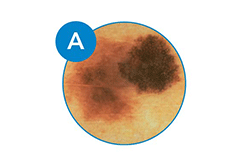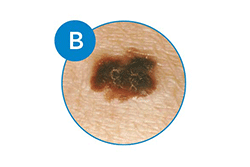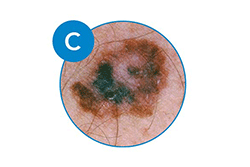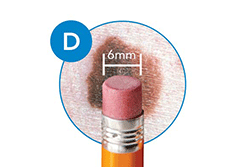Melanoma survivor? You really need to check your skin!
Have you been diagnosed and treated for melanoma? If so, skin self-exams are essential. Once you’ve had melanoma, you have a higher risk of getting another one. It’s also possible for the cancer to return.
Checking your skin helps you find melanoma in its earliest stage. The earlier melanoma is found and treated, the greater the likelihood that it will be completely removed.
Skin self-exam
Thorough skin self-exams can help melanoma survivors find new cancers early.

Seeing a dermatologist? Skin exams still essential
Even if you keep all follow-up appointments with your dermatologist, skin self-exams are important. Studies show that skin self-exams help melanoma survivors find earlier melanomas.
If you’re like many melanoma survivors, you may feel that you don’t have the skills to check your skin. You may feel uncertain about what to look for. This can leave you feeling that only your dermatologist should check your skin. That’s understandable.
Because skin self-exams are so important, dermatologists have worked with the AAD to create materials that can help you check your skin with confidence. With these materials, you can quickly learn what to look for, how to check your skin, and when to call your dermatologist.
Your partner can help you check your skin
A research study found that partners of patients with melanoma can effectively perform skin exams and find new melanomas.

What to look for
To make it easy for people to remember what to look for on their skin, dermatologists created the ABCDEs of melanoma:
 | A is for Asymmetry One half of the spot is unlike the other half. | |
 | B is for Border The spot has an irregular, scalloped, or poorly defined border. | |
 | C is for Color The spot has varying colors from one area to the next, such as shades of tan, brown or black, or areas of white, red, or blue. | |
 | D is for Diameter While melanomas are usually greater than 6 millimeters, or about the size of a pencil eraser, when diagnosed, they can be smaller. | |
 E is for Evolving The spot looks different from the rest or is changing in size, shape, or color. | ||
How to check your skin
Now that you know what to look for, it can be helpful to watch someone perform a skin exam. In this short video, you’ll review the ABCDEs of melanoma and see how a partner can help you check the hard-to-see areas like your back and scalp.
FIND SKIN CANCER: HOW TO PERFORM A SKIN SELF-EXAM
Regularly checking your skin can help catch skin cancer early, when it’s highly treatable. Follow these tips from board-certified dermatologists to check your skin for signs of skin cancer.
What you need
If you prefer to check your skin by yourself, you’ll need the following:
Full-length mirror
Handheld mirror
The AAD's Body Mole Map can also help. On this one-page sheet, you’ll find the ABCDEs of melanoma, pictures that show you how to perform a skin self-exam, and a place to record what your moles look like so that you can spot a change.
How often you need to check your skin
This varies. Ask your dermatologist how often you should check your skin.

Ready, set, check your skin
Today is a great time to practice what you’ve learned. Find a quiet, private place where you can check your entire body. Be sure to check your arms, feet, space between your toes, scalp, back, and buttocks.
If you feel uncertain about anything, be sure to let your dermatologist know. Your dermatologist can show you exactly what to do.
When to call your dermatologist
You want to call your dermatologist’s office immediately if you find anything on your skin that is:
Similar to any of the ABCDEs of melanoma
Growing
Itching
Bleeding
Changing in any way
Be sure the person who answers the phone knows that you’ve had melanoma and just found a suspicious spot. The earlier melanoma is found and treated, the greater the likelihood that it can be completely removed.
Related AAD resources
Images
References
Körner A, Drapeau M, et al. “Barriers and facilitators of adherence to medical advice on skin self-examination during melanoma follow-up care.” BMC Dermatol. 2013 Mar 1;13:3.
Robinson JK, Wayne JD, et al. “Early detection of new melanomas by patients with melanoma and their partners using a structured skin self-examination skills training intervention: A randomized clinical trial.” JAMA Dermatol. 2016 Sep 1;152(9):979-85.
 Atopic dermatitis: More FDA-approved treatments
Atopic dermatitis: More FDA-approved treatments
 Biosimilars: 14 FAQs
Biosimilars: 14 FAQs
 How to trim your nails
How to trim your nails
 Relieve uncontrollably itchy skin
Relieve uncontrollably itchy skin
 Fade dark spots
Fade dark spots
 Untreatable razor bumps or acne?
Untreatable razor bumps or acne?
 Tattoo removal
Tattoo removal
 Scar treatment
Scar treatment
 Free materials to help raise skin cancer awareness
Free materials to help raise skin cancer awareness
 Dermatologist-approved lesson plans, activities you can use
Dermatologist-approved lesson plans, activities you can use
 Find a Dermatologist
Find a Dermatologist
 What is a dermatologist?
What is a dermatologist?